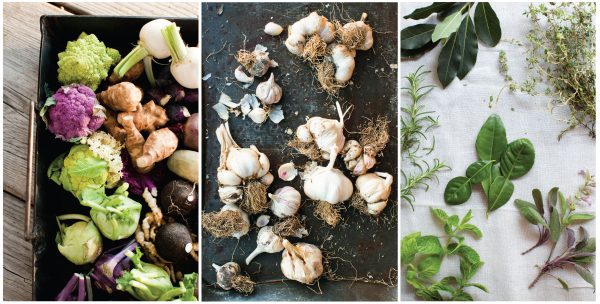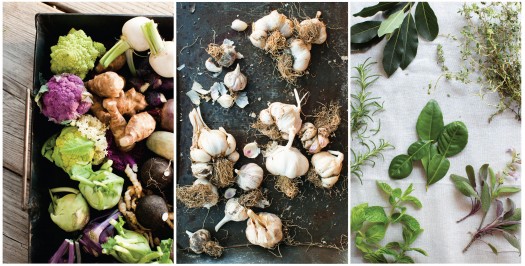Tips for Spring & Summer: Vegetables We Love
May 13, 2015
“[P]lant-based recipes aren’t just enticing and flavorful; these are anti-inflammatory, alkaline foods that balance hormones, blood sugar, and blood pressure. Simple to prepare yet effective, this is hydrating food, rich in the emollient oils that are so good for your skin, nervous system, and brain. They are designed to help relax tired muscles, soothe stress, and comfort you.
In general, most fresh produce has the maximum nutrients in it the moment it is picked. If you’ve tried freshly picked fruits or vegetables, you’ll have experienced just how superior the flavor and texture of this produce is over store-bought. It’s incomparable. The fresher the produce, the better.”
—From The Ranch at Live Oak Cookbook: Delicious Dishes from California’s Legendary Wellness Spa
The Benefits of Fresh Vegetables:

Asparagus: Asparagus spears contain more antioxidants than broccoli—but only if they’re freshly harvested (you might want to try growing your own). Even one day after they’ve been picked, asparagus contains just a quarter of the original nutrients. It’s sometimes tempting to use white asparagus spears for aesthetic reasons, but blanched asparagus lacks many of the phytonutrients that make regular green asparagus so good for you.
Eggplants: These contain a type of anthocyanin compound called nasunin, which is believed to protect brain cells; nasunin may have the potential to rebuild brain cells and slow down the brain’s aging process. Eggplants also contain antioxidant phenolics with the potential to protect against free radicals, and therefore protect against degenerative diseases like cancer and coronary diseases. To gain the benefits of these powerful phytonutrients, it’s essential to eat the whole vegetable.
Greens such as spinach, romaine, arugula, and dandelion leaves are some of the healthiest vegetables, especially when eaten raw. For greens, choose varieties with the darkest leaf color; these have more lutein, a phytonutrient with antiaging properties that helps the eyes, nerve endings, and the brain. For lettuces, the darker the red, the more anthocyanins they contain, plus dark red lettuces can have more lutein.
Garlic: This superfood is probably the most potent medicine in your pantry. It boasts a complex array of nutrients and has been used as a medicine for centuries. The two main medicinal compounds in garlic are allicin and quercetin. Allicin is a strong antimicrobial; three cloves of garlic contain the same level of antimicrobial activity as a dose of penicillin. Quercetin has antiviral, antibacterial, and anticancer qualities—and garlic has the strongest cancer-preventing properties of any vegetable, including kale.
Berries: They’re all full of blue and red anthocyanin compounds, which give them their beautiful colors. Juicy and delicious, berries are high in vitamin C, and they contain the phytonutrients you need to help you to absorb it. They are rich in antioxidants, containing up to two hundred compounds with antioxidant qualities.
Oranges: This readily available citrus fruit contains 170 different antioxidant compounds, many of which are found in the skin and pith but not in the juice. The juice is sweeter, and boasts many nutritional benefits, too, because of its rich vitamin C levels, so good for healthy skin and collagen production, but we’ve included the zest along with the juice in as many of our recipes as possible, because we love whole foods and the flavor and healthy benefits they deliver.
Chickpeas: Also called garbanzo beans, chickpeas are high in both calcium and fiber. They have a unique texture when cooked, hence their ubiquitous use as a base for hummus, and their mild nutty taste makes them a great addition to entrées needing a light protein.
Ginger and turmeric: They are closely related, which is why they look so similar and can be used almost interchangeably in recipes. Most fresh ginger sold in markets is old and tough, but strongly flavored. The younger the ginger, the more mildly flavored and tender it is. The youngest ginger has pink tips and is called “stem ginger.” It is only found seasonally in spring, and only in specialty health food stores. Fresh turmeric has just started to appear in whole foods stores; you can find it from February to October. Both ginger and turmeric help the immune system, aid digestion, and are widely praised for their anti-inflammatory properties.